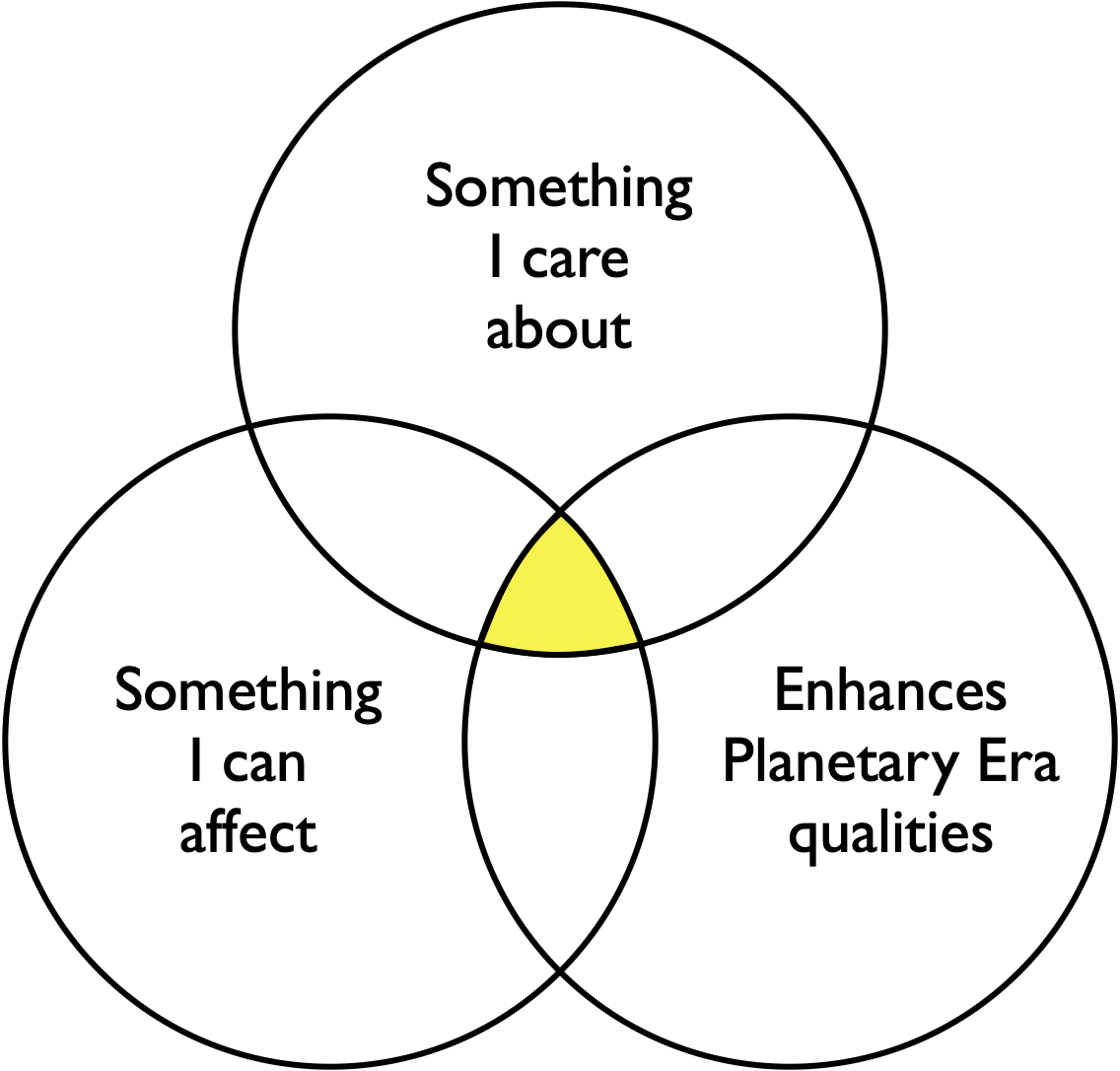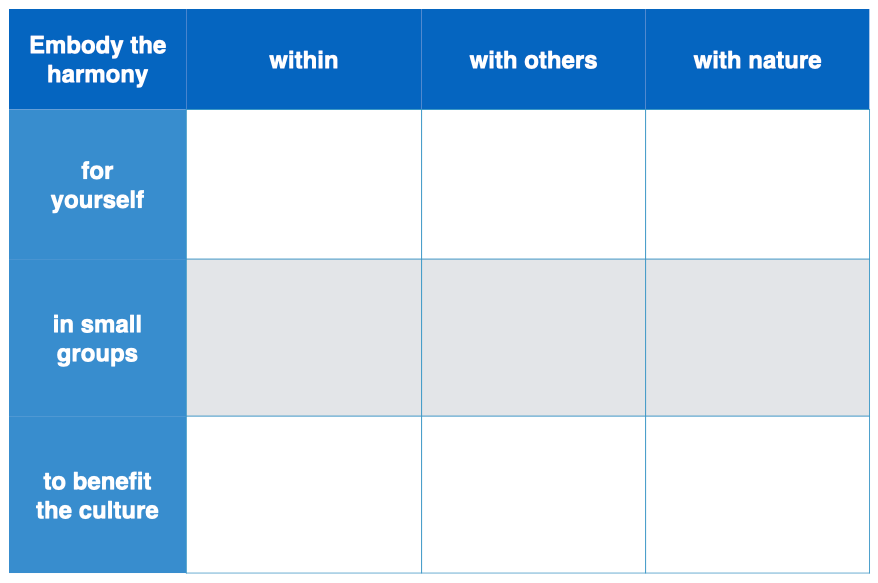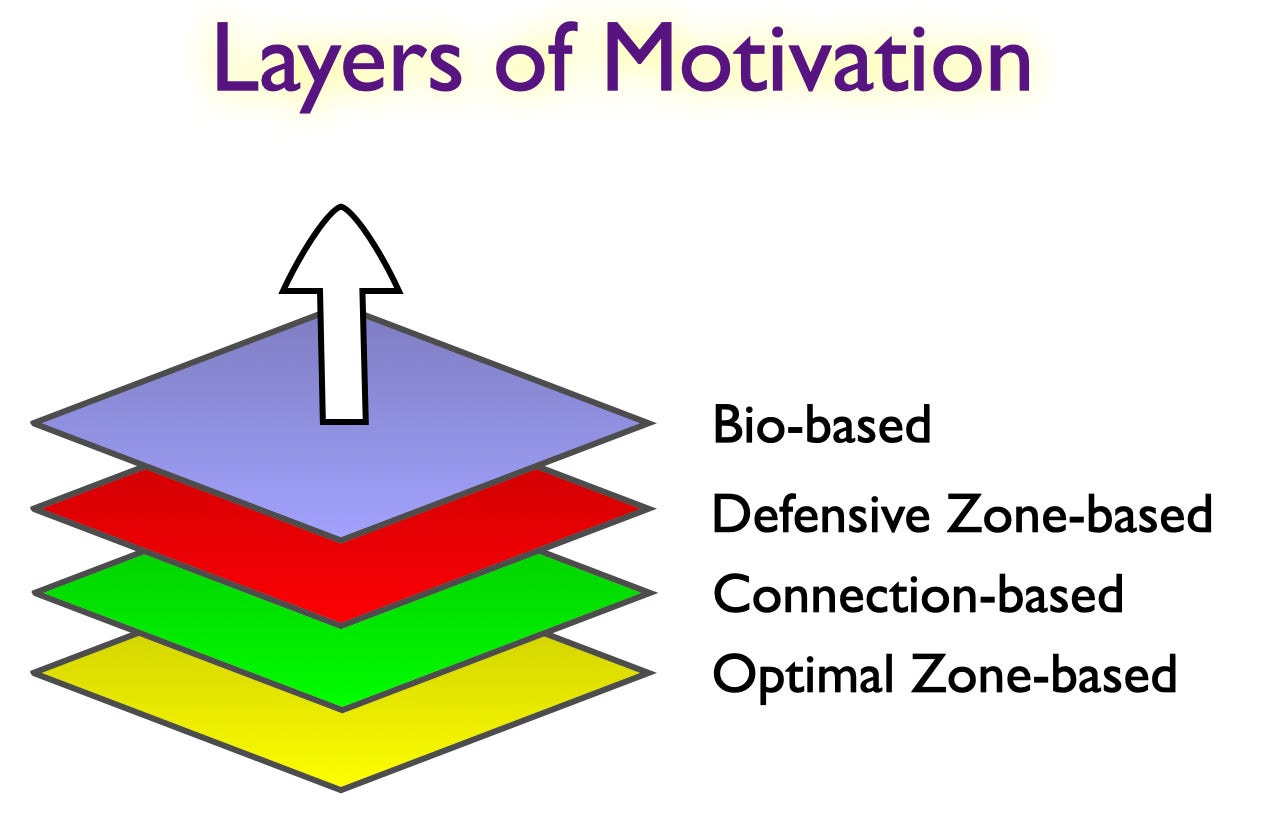[This is part of BFNow Self-Study Module 6: How Change Works. For more about the overall Self-Study program, please look at About BFNow Self-Study and BFNow Self-Study Orientation.]
Let me encourage you, if you haven’t done so already, to pause, relax and release, perhaps with a big stretch or three deep breaths.
In Cultural Co-Evolver, my August 2021 presentation at The Stoa, I described a co-evolver as a cultural change agent who understands culture as a complex adaptive system.
Actually being such a co-evolver combines two important dimensions, one general and the other quite personal. All co-evolvers need a shared toolkit that includes a general understanding of the way cultural change works and the capacities to influence it. At the same time, each of us needs to discern for ourselves, what is truly mine to do?
I’d like to use this exploration to address both of these.
That said, the experiential is about what is truly mine to do?, so if you want to keep it simple, focus on the second half of this page.
The shared co-evolver toolkit
The first three explorations have covered important parts of the toolkit – understanding culture as a complex adaptive system and then understanding how culture evolves. To this I would add the more specific understanding that we’re in a time of profound cultural transition – as big as the shift out of hunting and gathering and into agriculture and cities. While there are no guarantees, this transition has the potential to evolve into something we would recognize as the Planetary Era.
Getting there will require new cultural patterns. Specifically, we need to go beyond what I describe as the main dysfunctions of modernist, Age-of-Enlightenment-based cultures:
Cluelessness about psychodynamics
Narrow modes of cognition
Outmoded strategy for success.
Inverting these dysfunctions reveals three powerful capacities for our co-evolver toolkit.
Savvy about psychodynamics
Skillful with diverse modes of cognition
Adept at the new strategy for success.
Each of these is a big territory. I’m going into each one in my “Philosopher in Residence” events at The Stoa, but that’s just a start. In this exploration, I’d like to indicate how what we’re doing in BFNow contributes to and provides examples for each capacity.
Be savvy about psychodynamics
I describe psychodynamics as “the conscious and subconscious mental and emotional forces that determine personality and motivation.” We’ve focused a lot on this, especially in the first three modules. Here are examples of being savvy about psychodynamics:
With yourself
Practice self-awareness and self-compassion (Module 1)
Become aware of your trauma triggers and defenses and work to unwind them (Module 3)
Understand your motivations (from the Layers of Motivation)
Act from your Optimal Zone (Modules 1 & 3)
Focus on what you want (aligns you with your Optimal Zone), not what you don’t want (would align you with your defenses)
With others
See others as territories (Module 2)
Compassionately understand their motivations (Modules 1 & 3) Offer a healing response (Module 3)
Motivate through Optimal Zone qualities – like love, creativity, curiosity and future-pull – rather than fear
Be skillful with diverse modes of cognition
I describe cognition as “the mental action or process of acquiring knowledge and understanding through thought, experience, and the senses” – another big territory! Here are examples of being skillful with diverse modes of cognition:
Learn to move between object perception and territory perception (Module 2)
Learn to move between categorical thinking and system or map thinking (Module 2)
Learn to move among linguistic, visual and kinesthetic thinking; understand the systems around you (Modules 2, 4 & 6)
With others, build common ground and shared understandings drawing on all the modes (Module 5)
Be adept at the new strategy for success
I describe success as “anything that improves the harmony within, with others and with nature, for our selves, in groups and for the culture.” More simply, you can think of success as a win-win-win outcome: a win for you, a win for the other(s) and a win for the whole.
This has always been the nicer approach but in the past it hasn’t had much practical success, being overshadowed by the win-lose approach. What’s different now is that in today’s highly interconnected society, the ripple-effect benefits from win-win-win accumulate faster and stronger. This tips the balance and makes the win-win-win approach now the smarter approach as well as the nicer one. We’re in a time of transition and the old win-lose approach has a lot of legacy-inertia behind it, so it may not yet look like we’ve reached the tipping point, but from my perspective, the trends are headed that way.
Here are examples of being adept at the new strategy for success:
Understand culture as a complex adaptive system rather than as a machine or a controllable hierarchy.
Embody the 3 harmonies rather than enforcing the 3 dominations.
Catalyze culture change directly through innovate-implement-communicate and the diffusion of innovations.
Use the other two capacities: be savvy about psychodynamics and skillful with diverse modes of cognition.
Focus your efforts where they will do the most good, which is likely to be with the next ring of adopters for whatever innovation you are co-evolving.
Help your collaborators to act from their optimal zone as much as possible.
Once in the optimal zone, help your collaborators to approach your shared challenges with curiosity, creativity and design-thinking. Use this to find those win-win-win outcomes.
What is truly mine to do?
It’s all well and good to have a fabulous toolkit, but what do you actually do with it? Each of us will have our own unique answer. Getting there, we each need to discern, what is truly mine to do?
When I work with this question, I find it helpful to look for the sweet-spot overlap of three qualities:
I have only so much time and energy so I want what I do to get a strong yes! in each of these circles.
Let’s explore each in turn:
Enhances Planetary Era Qualities
The new cultural patterns we need for the Planetary Era cover a vast territory. This grid is one map for that territory:
For me, a core message of this grid is that it’s all needed, it’s all important. Anything you do that falls somewhere on this grid, or in some combination of places, contributes to progress toward the Planetary Era, so this condition should be easy to meet.
Something I care about
We are likely to say that we care about many things, but some things have more personal energy than others. Ask yourself:
As I look back over my life, is this something I’ve cared about over time? Is it a recurring theme?
When I imagine myself taking a next step with this activity, what do I notice in my body? Areas of tension? Warmth? Cold? Relaxation? Relief? Heaviness?
What do my various subpersonalities have to say about this activity?
When I sleep on it, how do I feel about it in the morning?
It can be helpful to use the Layers of Motivation (see the PS below) as a prompt to sort out the various influences that are motivating you:
You don’t need total alignment in order to take action but it helps if at least all your subpersonalities can consent to moving forward and your motivation feels sustainable and strongly Optimal Zone – based.
Something I can affect
We each have a sphere of agency – situation, people, groups, projects – that we are connected to and can affect. Often our sphere of agency is larger than we imagine but it’s fine to start with something you believe you have a reasonable chance of affecting.
As our experience grows and our networks expand, our sphere of agency is likely to change. At least for me, that dynamism is part of what makes being a co-evolver so interesting and fun.
As you focus in on what’s yours to do, I recommend you pick something that feels both doable and perhaps a bit of a stretch. That’s a growthful sweet spot in your sphere of agency.
Experiential
Think of one or more activities that you either are doing or might do. One might be something you’ve done for a long time, another might be something that feels like a fresh possibility.
Use the perspective of each of the three circles to assess each activity. If you have more than one activity, how do they compare from these perspectives? Does this help you clarify what is truly yours to do?
This kind of inquiry is good for any activity and especially good when you are contemplating some kind of never-been-done-before co-evolver activity.
If you have questions or comments, please post them here.
Thanks,
Robert
[Link back to the Module 6: How Change Works Overview page.]
PS - Understanding motivation
As we navigate through life, it’s important to understand our motivations as well as those of others. As part of “integrating” the course so far, I’d like to share some ways I’ve found helpful in understanding my own motivations. (I included this in the Savvy about Psychodynamics Stoa talk, so if you’ve seen that, the following may seem familiar.)
Layers of motivation
You may be familiar with Maslow’s Hierarchy of Needs, which was part of his 1943 paper A Theory of Human Motivation:
I thought it was intriguing when I first came across it decades ago but it’s never really worked for me in practice. So I’ve put together another stack that isn’t a strict hierarchy but rather a series of layers with dynamically varying transparency.
The idea here is that the motivation we experience emerges from a stack of many different motivating influences, each represented by a layer. The higher a layer is in the stack, the stronger its ability to assert itself, although it may not be active all of the time. When one layer is quiet (relatively transparent), it allows the influence from other layers to come through more fully. The layers are:
Bio-based – Our bodies need air, warmth, water, food, sleep, etc. and will call for them strongly when there is a lack.
Defensive Zone-based – Our defense patterns (as in Module 3) include emotionally powerful motivations that are much more influential than most people recognize. It’s not just the triggered times. More pervasive are all of our anticipatory defenses, always there in the background with strong opinions about what’s safe and what isn’t, where we should direct our anger and where we shouldn’t, etc. These may be expressed through various subpersonalities.
Connection-based – As deeply social beings, we’re strongly influenced by those we are (or have been) in close relationships with and those in our wider social networks. Soldiers die for their buddies, not for a cause. We will believe and do all kinds of things to establish and maintain these relationships. While this could be considered part of either the layer above or below it, I feel its strong instinctual basis merits its own layer.
Optimal Zone-based – When I’m in my Optimal Zone, what motivates me is love and creativity. My sense is that these are always with me but they can be hidden or distorted by the layers above it.
When I’m trying to make a significant choice, I find it helpful to
Make sure all my bio needs are currently met
Use my self-awareness and my knowledge of my own defense patterns to see how these might be coloring whatever motivation I’m feeling
Make sure I’m at peace in my various relationships, aware of the impact my choice will have on others yet clear about charting my own path without undue influence from the opinions of those around me
Get into my Optimal Zone as much as possible
Sustainable motivation
The big issues facing humanity as well as persistent issues in our personal lives are long-arc urgencies rather than emergencies. If we try to motivate ourselves to deal with these through fear, anger or any other motivator that produces adrenaline, it will lead to exhaustion, burnout and diminished agency.
What works for the long run are the motivators associated with the Optimal Zone – love, creativity and what I like to call future-pull (the anticipation of something positive in the future). This is why it’s so important, both for yourself and in working with others, to avoid motivation based on fear. As I described with the Equation of Change, it’s fine to point out the downsides of continuing with business-as-usual, but don’t dwell there.
The whole Bright Future approach is meant to provide a grounded, clear-eyed support for the long-haul through what will likely continue to be challenging times – but also times of great opportunity for humanity and the earth if we can stay in touch with our Optimal Zone well enough to see them.
May you find your own well-springs of long-arc motivation!






